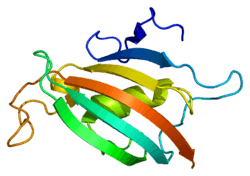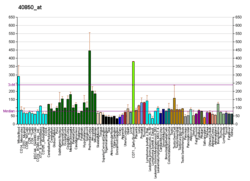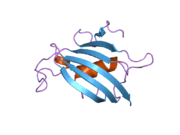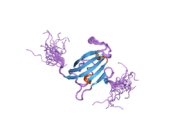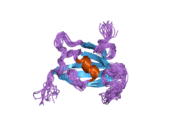FKBP8
FK506-binding protein 8 is a protein that in humans is encoded by the FKBP8 gene.[5][6]
The protein encoded by this gene is a member of the immunophilin protein family, which play a role in immunoregulation and basic cellular processes involving protein folding and trafficking. Unlike the other members of the family, this encoded protein does not seem to have PPIase/rotamase activity. It may have a role in neurons associated with memory function.[6]
References
- 1 2 3 GRCh38: Ensembl release 89: ENSG00000105701 - Ensembl, May 2017
- 1 2 3 GRCm38: Ensembl release 89: ENSMUSG00000019428 - Ensembl, May 2017
- ↑ "Human PubMed Reference:".
- ↑ "Mouse PubMed Reference:".
- ↑ Lam E, Martin M, Wiederrecht G (Sep 1995). "Isolation of a cDNA encoding a novel human FK506-binding protein homolog containing leucine zipper and tetratricopeptide repeat motifs". Gene. 160 (2): 297–302. doi:10.1016/0378-1119(95)00216-S. PMID 7543869.
- 1 2 "Entrez Gene: FKBP8 FK506 binding protein 8, 38kDa".
Further reading
- Bonaldo MF, Lennon G, Soares MB (1997). "Normalization and subtraction: two approaches to facilitate gene discovery". Genome Res. 6 (9): 791–806. doi:10.1101/gr.6.9.791. PMID 8889548.
- Pedersen KM, Finsen B, Celis JE, Jensen NA (1999). "muFKBP38: a novel murine immunophilin homolog differentially expressed in Schwannoma cells and central nervous system neurons in vivo". Electrophoresis. 20 (2): 249–55. doi:10.1002/(SICI)1522-2683(19990201)20:2<249::AID-ELPS249>3.0.CO;2-F. PMID 10197430.
- Hartley JL, Temple GF, Brasch MA (2001). "DNA cloning using in vitro site-specific recombination". Genome Res. 10 (11): 1788–95. doi:10.1101/gr.143000. PMC 310948. PMID 11076863.
- Wiemann S, Weil B, Wellenreuther R, et al. (2001). "Toward a catalog of human genes and proteins: sequencing and analysis of 500 novel complete protein coding human cDNAs". Genome Res. 11 (3): 422–35. doi:10.1101/gr.GR1547R. PMC 311072. PMID 11230166.
- Strausberg RL, Feingold EA, Grouse LH, et al. (2003). "Generation and initial analysis of more than 15,000 full-length human and mouse cDNA sequences". Proc. Natl. Acad. Sci. U.S.A. 99 (26): 16899–903. doi:10.1073/pnas.242603899. PMC 139241. PMID 12477932.
- Shirane M, Nakayama KI (2003). "Inherent calcineurin inhibitor FKBP38 targets Bcl-2 to mitochondria and inhibits apoptosis". Nat. Cell Biol. 5 (1): 28–37. doi:10.1038/ncb894. PMID 12510191.
- Rosner M, Hofer K, Kubista M, Hengstschläger M (2003). "Cell size regulation by the human TSC tumor suppressor proteins depends on PI3K and FKBP38". Oncogene. 22 (31): 4786–98. doi:10.1038/sj.onc.1206776. PMID 12894220.
- Grimwood J, Gordon LA, Olsen A, et al. (2004). "The DNA sequence and biology of human chromosome 19". Nature. 428 (6982): 529–35. doi:10.1038/nature02399. PMID 15057824.
- Bulgakov OV, Eggenschwiler JT, Hong DH, et al. (2004). "FKBP8 is a negative regulator of mouse sonic hedgehog signaling in neural tissues". Development. 131 (9): 2149–59. doi:10.1242/dev.01122. PMID 15105374.
- Gerhard DS, Wagner L, Feingold EA, et al. (2004). "The status, quality, and expansion of the NIH full-length cDNA project: the Mammalian Gene Collection (MGC)". Genome Res. 14 (10B): 2121–7. doi:10.1101/gr.2596504. PMC 528928. PMID 15489334.
- Wiemann S, Arlt D, Huber W, et al. (2004). "From ORFeome to biology: a functional genomics pipeline". Genome Res. 14 (10B): 2136–44. doi:10.1101/gr.2576704. PMC 528930. PMID 15489336.
- Rush J, Moritz A, Lee KA, et al. (2005). "Immunoaffinity profiling of tyrosine phosphorylation in cancer cells". Nat. Biotechnol. 23 (1): 94–101. doi:10.1038/nbt1046. PMID 15592455.
- Kang CB, Tai J, Chia J, Yoon HS (2005). "The flexible loop of Bcl-2 is required for molecular interaction with immunosuppressant FK-506 binding protein 38 (FKBP38)". FEBS Lett. 579 (6): 1469–76. doi:10.1016/j.febslet.2005.01.053. PMID 15733859.
- Weiwad M, Edlich F, Erdmann F, et al. (2005). "A reassessment of the inhibitory capacity of human FKBP38 on calcineurin". FEBS Lett. 579 (7): 1591–6. doi:10.1016/j.febslet.2004.12.098. PMID 15757646.
- Edlich F, Weiwad M, Erdmann F, et al. (2005). "Bcl-2 regulator FKBP38 is activated by Ca2+/calmodulin". EMBO J. 24 (14): 2688–99. doi:10.1038/sj.emboj.7600739. PMC 1176465. PMID 15990872.
- Kang CB, Feng L, Chia J, Yoon HS (2005). "Molecular characterization of FK-506 binding protein 38 and its potential regulatory role on the anti-apoptotic protein Bcl-2". Biochem. Biophys. Res. Commun. 337 (1): 30–8. doi:10.1016/j.bbrc.2005.09.023. PMID 16176796.
- Rual JF, Venkatesan K, Hao T, et al. (2005). "Towards a proteome-scale map of the human protein-protein interaction network". Nature. 437 (7062): 1173–8. doi:10.1038/nature04209. PMID 16189514.
- Oh JH, Yang JO, Hahn Y, et al. (2006). "Transcriptome analysis of human gastric cancer". Mamm. Genome. 16 (12): 942–54. doi:10.1007/s00335-005-0075-2. PMID 16341674.
- Mehrle A, Rosenfelder H, Schupp I, et al. (2006). "The LIFEdb database in 2006". Nucleic Acids Res. 34 (Database issue): D415–8. doi:10.1093/nar/gkj139. PMC 1347501. PMID 16381901.
This article is issued from
Wikipedia.
The text is licensed under Creative Commons - Attribution - Sharealike.
Additional terms may apply for the media files.
